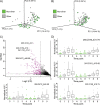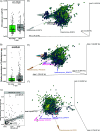The Molecular Effect of Wearing Silver-Threaded Clothing on the Human Skin
- PMID: 36722970
- PMCID: PMC9948701
- DOI: 10.1128/msystems.00922-22
The Molecular Effect of Wearing Silver-Threaded Clothing on the Human Skin
Abstract
With growing awareness that what we put in and on our bodies affects our health and wellbeing, little is still known about the impact of textiles on the human skin. Athletic wear often uses silver threading to improve hygiene, but little is known about its effect on the body's largest organ. In this study, we investigated the impact of such clothing on the skin's chemistry and microbiome. Samples were collected from different body sites of a dozen volunteers over the course of 12 weeks. The changes induced by the antibacterial clothing were specific for individuals, but more so defined by gender and body site. Unexpectedly, the microbial biomass on skin increased in the majority of the volunteers when wearing silver-threaded T-shirts. Although the most abundant taxa remained unaffected, silver caused an increase in diversity and richness of low-abundant bacteria and a decrease in chemical diversity. Both effects were mainly observed for women. The hallmark of the induced changes was an increase in the abundance of various monounsaturated fatty acids (MUFAs), especially in the upper back. Several microbe-metabolite associations were uncovered, including Cutibacterium, detected in the upper back area, which was correlated with the distribution of MUFAs, and Anaerococcus spp. found in the underarms, which were associated with a series of different bile acids. Overall, these findings point to a notable impact of the silver-threaded material on the skin microbiome and chemistry. We observed that relatively subtle changes in the microbiome result in pronounced shifts in molecular composition. IMPORTANCE The impact of silver-threaded material on human skin chemistry and microbiome is largely unknown. Although the most abundant taxa remained unaffected, silver caused an increase in diversity and richness of low-abundant bacteria and a decrease in chemical diversity. The major change was an increase in the abundance of various monounsaturated fatty acids that were also correlated with Cutibacterium. Additionally, Anaerococcus spp., found in the underarms, were associated with different bile acids in the armpit samples. Overall, the impact of the silver-threaded clothing was gender and body site specific.
Keywords: clothing; outfit; silver-threaded clothing; skin chemistry; skin microbiome.
Conflict of interest statement
The authors declare a conflict of interest. R.G. is a part of the company Lululemon, which provided the material for the study and partially sponsored the research. P.C.D. is a scientific advisor for Sirenas, Cybele, and Galileo and a scientific advisor and founder of Enveda and OMETA with approval by University of California, San Diego. A.A.A. and A.V.M. are co-founders of Arome Science Inc.
Figures



References
-
- Dąbrowska J, Wójcik M, Boreński G, Bator D. 2020. Influence of diet on the gut microbiota. J Educ Health Sport 10(5):33–41. doi:10.12775/JEHS.2020.10.05.003. - DOI
-
- Moissl-Eichinger C, Berg G, Grube M. 2018. Microbiome interplay and control. Frontiers Media SA, Lausanne, Switzerland.
-
- Jablonski NG. 2008. Skin: a natural history. University of California Press, Oakland, CA.
Publication types
MeSH terms
Substances
Grants and funding
LinkOut - more resources
Full Text Sources
Miscellaneous

